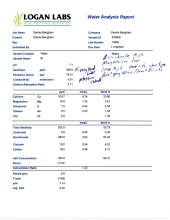I finally got my well drilled by a professional, got the issues figured out with the SimplePump, etc. The next step in the project is to work on a better treatment option. We are currently RO'ing all of the water to the entire house, which I know is not efficient or sustainable by any stretch of the imagination. I went with that as a quick and sure fire way to get the water to a "wont fudge up my water pipes" state, but do not want to rely on Amazon bringing me new filters and membranes long term.
The problem is that our well water is crazy high in TDS, calcium, iron, sulfate, and manganese. If I pump it into a holding tank, it will be golden yellow within about 24 hours as the sulfur oxidizes. The iron forming rust particles will mess up a 5 micron filter in a day or two. Any spilled water will evaporated to a thick white calcium crust and water spots immediately. I am attaching a well water test from September to put some numbers to what is going on here.
The goal is to make as much water of sufficient quality for each use, even if multiple processes or stages of treatment need to be done in different areas, and to waste as little water as as possible. Obviously our drinking water needs to be the cleanest, and laundry water good enough that I do not end up with all orange clothes. I do want to add aquaponics projects this year and I know input water to that also needs to be very very clean as well.
We do have hard copper cold and hot water pipes, possibly some soft copper hiding in places I cannot see in the crawl space. Most of the drain lines look like ABS plastic, and are going into a concrete septic and drain field of unknown material construction. We can continue to RO the 2-10 gallons a day needed for drinking and laundry if need be, but of course that is not ideal.
The SimplePump puts out around 1-2 gallons per minute, so we can get the ~100 gallons a day we use domestically into a holding tank in the garage in 1-2 hours. We need to get the bulk of the water at least de-sulfured, de-ironed, and softened enough to not stain and crust up water fixtures all over the house. I have the space to do one or two IBC tote sized tanks in the freeze-protected garage to do slow treatment solutions on. I am considering biosand/charcoal filtration beds, aeration and drain the precipitated sulfur and iron, reed beds, and any other bright ideas that anyone else has. Putting these processes in the right order or combining things like biosand and aeration into the same tank is half of the battle I'm sure. USDA zone 5b/6a here, so outdoor treatment year round is problematic, but solar or
compost heating of the process water is possible. We already have a DIY berkey set up, but I am sure putting straight well water into that would crust and clog up the filter in no time. All processes need to be as low maintenance as possible, as I am often gone for 2 weeks at a time...
I do not want to put a bunch of time and money into a large scale treatment option that might or might not work. So, that means either someone who really knows what they are doing having a sure fire brilliant idea, or we do small scale / incremental sizing up strategy until I can reliably make my ~100 gallons a day. My next step is to put a much larger and washable 50 and 5 micron filter in front of the RO to make it an easier and less frequent task to have to clean the orange brown gunk off of the first filters. I do plan to put a rainwater input into my domestic water system in the future, but after last year's drought going rainwater only is not only illegal here, but not very smart.
The sulfate and magnesium might actually be good to put on the 7.4-7.8 pH, high calcium clay soil we have on my land. However, I am wondering if the untreated well water, softened, and/or RO reject water can be put out on the garden area without making the ground saltier, or having iron problems, etc?
I am looking forward to hearing your ideas, experiences, etc to help me get one step closer to daily needs independence.
Thanks
- DH





 2
2




















